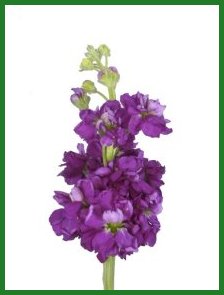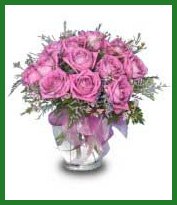 |
| Purple Stock |
Purple has always been a magical color. It is the color of mystery, royalty, passion and spirituality. Spectrally situated midway between the warm reds and the cool blues, purple can suggest either or both experiences. It has the ability to complement and enliven nearly any color scheme – a fact that floral designers have long realized. Purple is also a stylish hue that is appearing as an accent color in many contemporary interior design schemes. Fortunately, Mother Nature has provided a garden full of purple flowers, such as statice, tulips, liatris, iris, stock and more, from which a floral designer may choose. And what nature hasn’t produced, flower hybridizers have attempted to supply in the form of purple roses, carnations, callas and other flowers.
One blossom that has been gaining in popularity lately and which looks especially scrumptious in purple is the lisianthus. Though you may not be too familiar with it yet, lisianthus has been turning up in some of the most elegant flower arrangements.
Known botanically as Eustoma grandiflorum, lisianthus is valued for its broadly cup-shaped blossoms and delicate ruffled petals. They can look like open tulips or poppies. Double- and even triple-flowered lisianthus hybrids have resulted in luxurious blooms that resemble fully opened roses or peonies. Lisianthus buds are enchanting too, with the spirally twisted petals of the unopened flowers positioned at the ends of slender, graceful stems. They can add a wonderful sense of movement to a floral design, and their greenish color creates spectacular contrast against the more mature blossoms. Fortunately, lisianthus blooms are quite durable as cut flowers, provided they are well taken care of.
Lisianthus occurs in a variety of colors, including pink, white, ivory, lavender, pale green, buttercream yellow, and of course, purple. There are even bi-color varieties of lisianthus that have a band of color at the edge of the otherwise white petals. The deep, dark, eggplant hue of the true purple lisianthus exhibits a velvety sheen that almost begs to be touched. It’s a mysterious blackish-purple that seems almost unreal, like that of petunias (which don’t hold up well as cut flowers).
A deep purple color is also displayed by certain tulips. “Queen of the Night” is the tulip hybrid that has the darkest shade of purple. It’s been popular in gardens for decades. Another purple tulip is called “Negrita”. Though not quite as dark as the former, this tulip is more available to florists as it has a longer flowering season and can be forced into bloom more readily. Still another purple variety is “Purple Prince”, which is a slight shade paler than the others. Though available year round, tulips are especially plentiful during the spring season. Tulips are one of the few flowers that continue to elongate after they have been cut, often stretching toward a light source or opposite the force of gravity. A simple vase of tulips, accented with a delicate filler such as waxflower, makes a lovely gift – a spontaneous harbinger of spring that is constantly changing. To read more about tulips, click here to see our previous newsletter on the topic.
Other familiar spring flowers that occur in the color purple include iris, hyacinth, freesia, anemones, lilac and sweet peas.
Purple statice has long been a favorite filler flower in floral arrangements. It seems to last forever as a cut flower and it dries easily, meaning that its bright purple color can be enjoyed for years to come. Although it is available in other hues, such as pink, yellow, peach, blue and white, statice is most associated with the color purple. Ironically, the purple parts of the inflorescence are not really flowers at all. Rather, they are known botanically as “bracts”: modified leaf forms that serve to call attention to the insignificant “true” flowers. If you’ve kept fresh purple statice in a vase long enough, you may have noticed the little white true flowers eventually appearing amid the purple bracts.
One flower which is almost always seen in its purple form (although a white form also exists) is liatris. Commonly called “gayfeather”, liatris is a wildflower of the North American prairies. Liatris is valued in floral design for its strong, straight linear quality and for its vivid purple hue. It’s also very long-lasting as a cut flower. Liatris is unique among other so-called “line” flowers in that its florets open from the top down, as opposed to a flower like the gladiolus in which the lower florets open before the upper ones do. By pinching out the top florets as they die and re-cutting the bottom of the stem every few days, liatris can remain attractive in a vase for up to two weeks.
Dark purple callas have captivated the attention of floral designers lately. The variety known as “Schwarzwalder” is such a deep, dark burgundy-purple in color that it appears almost black. A brand new purple calla hybrid recently created in New Zealand is called “Hot Chocolate”. It’s even darker than the former, and has dark purple-black stems as well. Purple callas like these are now being carried by style-conscious brides in their wedding bouquets.
The summer perennial garden offers an abundance of purple blossoms which are suitable for cut flower arrangements. Included among them are larkspur, monkshood, hydrangea, trachelium, asters, veronica, alliums, phlox and stock.
Despite the fact that the carnation is such a common and popular flower for floral designers, it was not until quite recently that it was available in a true purple color. Reds, pinks, yellows, oranges, burgundies, whites and even greens are plentiful and have been extensively hybridized. But the color purple has never been produced by conventional breeding methods. It simply is not in the flower’s genetic code.
However, through the science of genetic engineering, we now have true purple carnations on the market. Gene splicers were able to extract the gene that generates the color purple from the petunia and insert it into the carnation, resulting in a series of four different shades of purple, ranging from a soft, pale lavender (named “Moonaqua”) to a deep, rich aubergine (“Moonvista”).
 |
| Romantic Vase of Bluebird Roses |
A similar program is underway in the development of a purple rose. Although there are now several good lavender-colored roses, such as “Sterling Silver” and “Blue Bird”, we have yet to see a truly purple rose. Since the rose is America’s number one favorite flower, it would seem that a really purple one would be quite popular. Time will tell.
Meanwhile, there are plenty of purple flowers available to your neighborhood florist, no matter what season of the year. Why not order a passionate arrangement of purple flowers today? Enjoy them in your own home, or have them delivered to someone special, either locally or out of town. Your professional florist has the skill to arrange your purple flowers in the most artistic way, and also knows how best to treat them to assure maximum vase life. Let the mysterious color purple work its magic for you today.
More intersting artilces:
Roses and More Roses
Daffodils, Hyacinths, Freesias and Tulips in Bloom
African Violets for One & All


 Find Your
Find Your 


Speak Your Mind